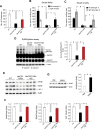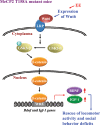Restoring Wnt6 signaling ameliorates behavioral deficits in MeCP2 T158A mouse model of Rett syndrome
- PMID: 31974426
- PMCID: PMC6978308
- DOI: 10.1038/s41598-020-57745-w
Restoring Wnt6 signaling ameliorates behavioral deficits in MeCP2 T158A mouse model of Rett syndrome
Abstract
The methyl-CpG-binding protein 2 gene, MECP2, is an X chromosome-linked gene encoding the MeCP2 protein, and mutations of MECP2 cause Rett syndrome (RTT). Previous study has shown that re-expression of SUMO-modified MeCP2 in Mecp2-null neurons rescues synaptic and behavioral deficits in Mecp2 conditional knockout mice, whereas about 12-fold decrease in Wnt6 mRNA level was found in MeCP2K412R sumo-mutant mice. Here, we examined the role of Wnt6 in MeCP2 T158A mouse model of RTT. Results show that lentiviral delivery of Wnt6 to the amygdala ameliorates locomotor impairment and social behavioral deficits in these animals. MeCP2 T158A mice show decreased level of GSK-3β phosphorylation and increased level of β-catenin phosphorylation. They also show reduced level of MeCP2 SUMOylation. These alterations were also restored by lenti-Wnt6 transduction. Further, both BDNF and IGF-1 expressions are decreased in MeCP2 T158A mice. Overexpression of Wnt6 increases Bdnf and Igf-1 promoter activity in HEK293T cells in a dose-dependent manner. Lenti-Wnt6 transduction to the amygdala similarly increases the mRNA level and protein expression of BDNF and IGF-1 in MeCP2 T158A mice. Moreover, environmental enrichment (EE) similarly ameliorates the locomotor and social behavioral deficits in MeCP2 T158A mice. One of the mechanisms underlying EE is mediated through enhanced MeCP2 SUMOylation and increased Wnt6 expression in these animals by EE.
Conflict of interest statement
The authors declare no competing interests.
Figures




References
Publication types
MeSH terms
Substances
LinkOut - more resources
Full Text Sources
Medical
Molecular Biology Databases
Research Materials
Miscellaneous

